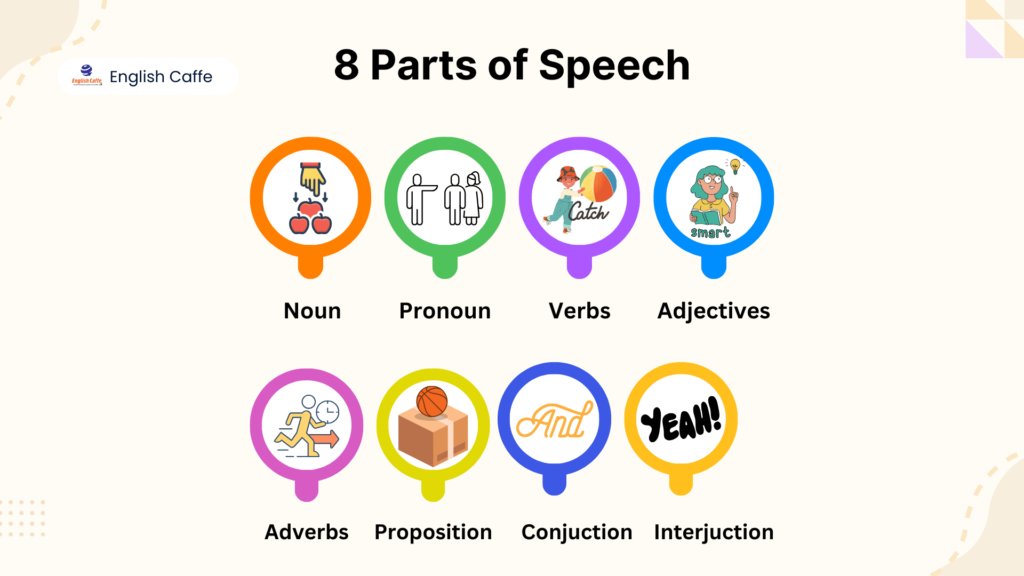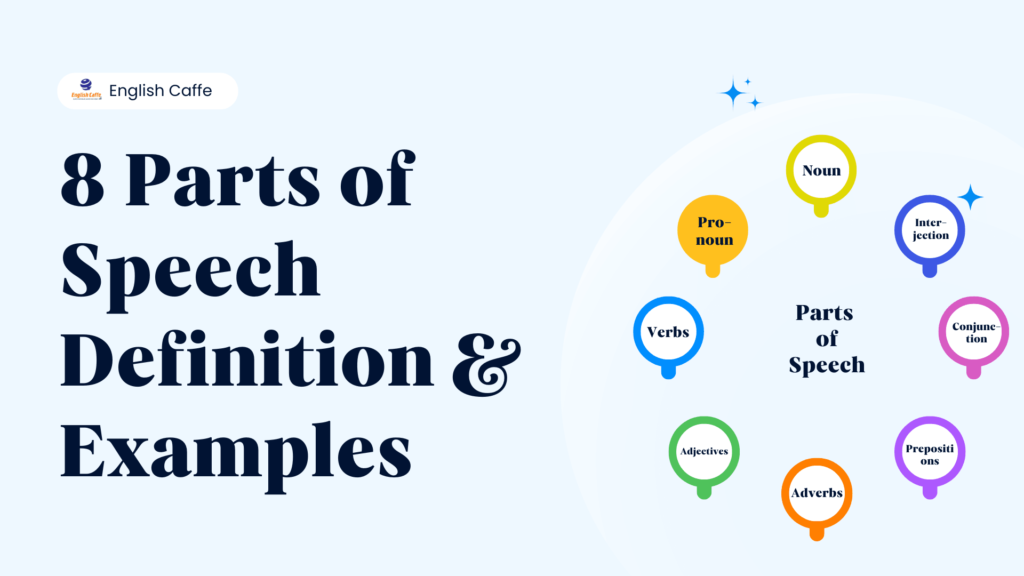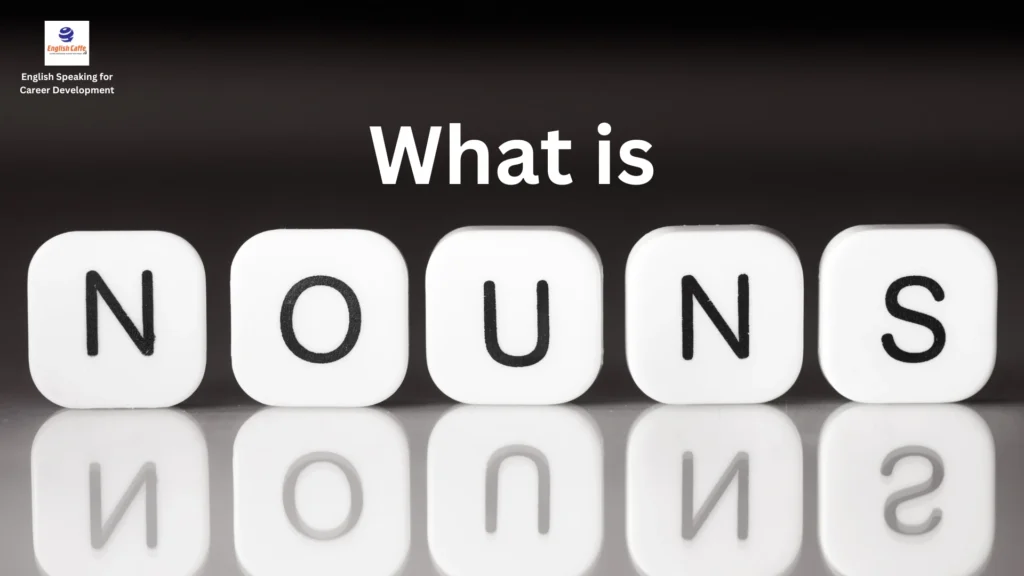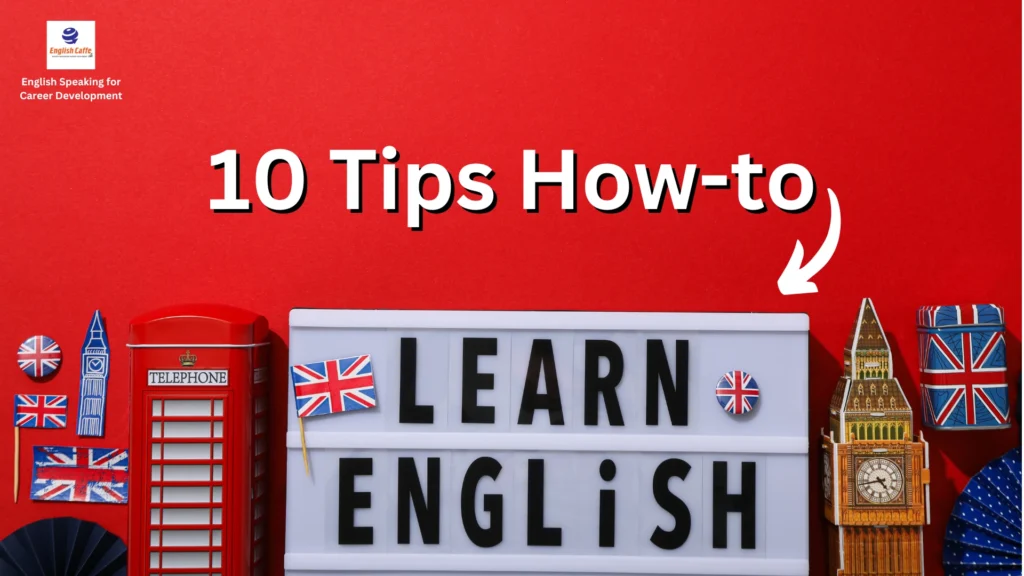In grammar, 8 parts of speech definitions and examples are the categories into which words are classified based on their function and role in a sentence.
Each has its own role in building meaning and conveying the intended message. Learning the parts of speech is a basic step toward the mastery of sentence structure composition and comprehension.
Are you looking for English speaking course in Noida?

8 Parts of Speech Definitions and Examples
There are a total of 8 parts of speech in English: each presents certain information within a sentence. Let’s get into a little detail on all these.
1. Noun
- Definition: A noun is a word that names a person, place, thing, or idea.
- Types of Nouns:
- Proper Nouns: Specific names of people, places, or things (e.g., London, Sarah).
- Common Nouns: General names for people, places, or things (e.g., city, dog).
- Abstract Nouns: Names of ideas, feelings, or qualities (e.g., happiness, freedom).
- Concrete Nouns: Names of things that can be touched or seen (e.g., table, car).
- Collective Nouns: Names of groups or collections of things (e.g., family, team).
- Countable Nouns: Nouns that can be counted (e.g., book/books).
- Uncountable Nouns: Nouns that cannot be counted (e.g., water, information).
Example Sentence:
- The dog ran to the park.
2. Pronoun
- Definition: A pronoun is a word that replaces a noun to avoid repetition.
- Types of Pronouns:
- Personal Pronouns: Refers to specific persons or things (e.g., he, she, it, they).
- Possessive Pronouns: Show ownership (e.g., his, her, their).
- Demonstrative Pronouns: Point to specific things (e.g., this, that, these, those).
- Relative Pronouns: Introduce relative clauses (e.g., who, which, that).
- Interrogative Pronouns: Used for asking questions (e.g., who, what, which).
- Indefinite Pronouns: Refer to non-specific things (e.g., anyone, everyone, someone).
Example Sentence:
- She is going to the store.
3. Verb
- Definition: A verb expresses action, occurrence, or state of being.
- Types of Verbs:
- Action Verbs: Describe actions (e.g., run, eat, write).
- Linking Verbs: Connect the subject with additional information (e.g., is, seem, appear).
- Auxiliary Verbs: Helping verbs that add meaning to the main verb (e.g., am, have, will).
- Modal Verbs: Express necessity, possibility, or ability (e.g., can, must, should).
Example Sentence:
- She sang a beautiful song.
4. Adjective
- Definition: An adjective describes or modifies a noun or pronoun by giving more information about it.
- Types of Adjectives:
- Descriptive Adjectives: Describe qualities (e.g., beautiful, tall).
- Quantitative Adjectives: Indicate quantity (e.g., many, few).
- Demonstrative Adjectives: Show which thing (e.g., this, those).
- Possessive Adjectives: Indicate ownership (e.g., my, her).
- Interrogative Adjectives: Used for asking questions (e.g., which, what).
- Comparative and Superlative Adjectives: Compare two or more things (e.g., taller, most beautiful).
Example Sentence:
- The blue sky is beautiful.
5. Adverb
- Definition: An adverb modifies a verb, adjective, or another adverb, providing more details like how, when, where, or to what extent something happens.
- Types of Adverbs:
- Adverbs of Manner: Describe how something is done (e.g., quickly, carefully).
- Adverbs of Time: Indicate when something happens (e.g., now, yesterday).
- Adverbs of Place: Indicate where something happens (e.g., here, everywhere).
- Adverbs of Frequency: Indicate how often something happens (e.g., always, never).
- Adverbs of Degree: Modify the intensity or degree of an adjective, verb, or other adverb (e.g., very, too).
Example Sentence:
- She runs quickly.
6. Preposition
- Definition: A preposition shows the relationship between a noun (or pronoun) and another word in the sentence, usually indicating location, direction, or time.
- Examples: in, on, at, under, over, between.
Example Sentence:
- The cat is on the table.
7. Conjunction
- Definition: A conjunction connects words, phrases, or clauses.
- Types of Conjunctions:
- Coordinating Conjunctions: Join elements of equal importance (e.g., and, but, or).
- Subordinating Conjunctions: Join a dependent clause to an independent clause (e.g., because, although, if).
- Correlative Conjunctions: Work in pairs (e.g., either…or, neither…nor).
Example Sentence:
- I wanted to go, but I was tired.
8. Interjection
- Definition: An interjection is a word or phrase that expresses strong emotion or sudden exclamation.
- Examples: wow, oh, ouch, hey.
Example Sentence:
- Wow, that’s amazing!
Frequently Asked Questions
A part of speech is a category of words that share a common function in a sentence. Examples of parts of speech include:
- Noun: dog, city
- Verb: run, is
- Adjective: beautiful, tall
- Adverb: quickly, very
In traditional grammar, there are 8 parts of speech. They are:
- Noun, Pronoun, Verb, Adjective, Adverb, Preposition, Conjunction, and Interjection.
There are 8 primary parts of speech. However, some modern grammarians break down certain categories further, which can lead to the identification of more than 8. But traditionally, it’s recognized as 8 parts of speech.
There are typically 8 primary parts of speech in English grammar, but some extended categories or classifications (like determiners, articles, etc.) are sometimes added in specific grammar models. For example, some sources might count articles (a, an, the) or determiners as separate, but these still fall under adjectives or pronouns in most traditional grammars.
Here are 10 examples of prepositions:
- in
- on
- at
- under
- over
- between
- above
- below
- through
- by



